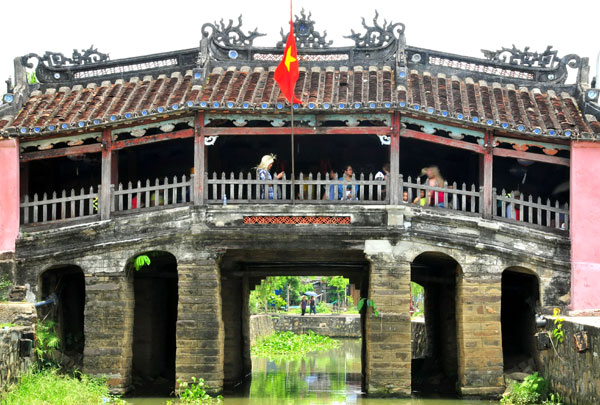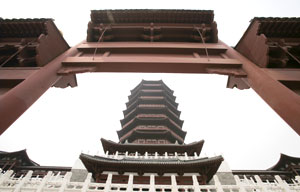Simply timeless
 |
|
The Japanese Bridge, constructed in the 17th century, is the symbol of Hoi An. Photos by Zhang Jianhua / Xinhua |
 |
|
A Chinese assembly hall in Hoi An. Such assembly halls were built by Chinese expatriates as a place to socialize and hold meetings. |
Over the past few years, the ancient town of Hoi An, located some 650 km south of Hanoi, has become a favorite tourist destination in Vietnam.
Hoi An, which used to be an international trading port in central Vietnam's Quang Nam province, has exceptionally well-preserved architectural wonders that include old houses, temples, pagodas, and other structures built from the 15th to the 19th century. In 1999, the old town was recognized as a World Heritage site by the United Nations Educational, Scientific and Cultural Organization.
Mostly made of wood in the traditional styles of Vietnam and neighboring regions, the structures found in the town have withstood the test of time. The town is also famous for its made-to-order shoes and sandals.
 |
|
A narrow street in Hoi An, a well-preserved ancient town in central Vietnam. |
"My shop sells a lot of shoes, and we can make various models of made-to-measure shoes that our customers, including foreign tourists, love to buy," a shop owner in Hoi An said.
The shop owner, who has been in the business for 10 years, said that his customers include tourists from Britain, France, Australia and the United States.
Making shoes is only one of the various industries in Hoi An, which is now considered a paradise for shoppers because of its high-quality locally made products that are sold at low prices.
According to old-timers here, Chinese and Japanese traders and craftsmen flocked to Hoi An during the 18th century, and some of them settled permanently in the town.
Among the structures in Hoi An that bear Chinese and Japanese influences are the Chinese temples and assembly halls as well as a Japanese covered bridge known as Japanese Bridge.
The assembly halls are places where Chinese expatriates used to socialize and hold meetings. There are five assembly halls in Hoi An built by different groups of Chinese immigrants - Fujian, Qiongfu, Chaozhou, Guang Zhao, and the Chinese Assembly Hall.
Most of the assembly halls in Hoi An have the same layout, including a grand gate, a beautiful garden, a main hall and a large altar room. However, because each Chinese community has its own beliefs, different assembly halls worship different gods and goddesses.
The Japanese Bridge, constructed in the 17th century, is the most prominent Japanese-built structure now found in Hoi An. It has been officially selected to be the symbol of Hoi An.
The bridge has an arched roof skillfully carved with many fine designs. The two entrances to the bridge are guarded by a pair of monkeys on one side and a pair of dogs on the other.
According to legend, there once lived an enormous monster whose head was in India, its tail in Japan and its body in Vietnam. Whenever the monster moved, terrible disasters, such as floods and earthquakes happened in the three countries. Thus, in addition to transporting goods and people, the bridge was also believed to protect against the monster.
Besides its cultural and historical value, a major attraction in Hoi An that makes it a "shopper's paradise" is its tailors. There are hundreds of tailors in the town who are ready to make any kinds of clothes.
Hoi An is also noted for its hand-crafted lanterns. Lanterns appear on every corner of the ancient town, not just in houses.
Once a month, on the full moon, the old town switches off its street lamps and fluorescent lights and is turned into a fairytale land by the warm glow of lanterns made of silk, glass and paper that cast a magical spell on visitors.
















